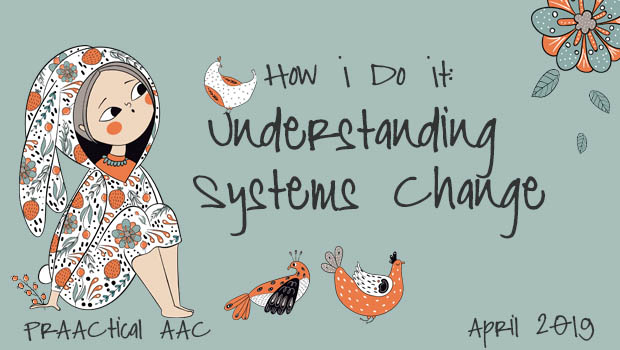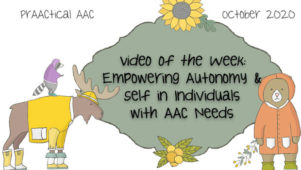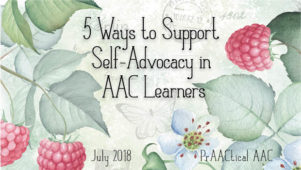How I Do It: Understanding Systems Change

Have you ever dreamed of taking a detour in your AAC work to address the needs from a totally different direction? Special educator Sarah Mueller did just that. Follow along as she tells us about her journey from teacher to student.
::::::::::::::::::::::::::::::::::::::::::::::::::::::::::::::::::::::::::::::::::::::::::::::::::
“Autism isn’t something a person has or a ‘shell’ that a person is trapped inside. There’s no normal child hidden behind the autism. Autism is a way of being. It is pervasive; it colors every experience, every sensation, perception, thought, emotion, and encounter, every aspect of existence. It is not possible to separate the autism from the person – and if it were possible, the person you’d have left would not be the same person you started with. This is important, so take a moment to consider it: Autism is a way of being. It is not possible to separate the person from the autism.” – Jim Sinclair
Many avid PrAACtical AAC blog followers may remember me from my previous posts focusing on older students who use AAC. I enjoyed being a high school special education teacher for a few years to teenagers and young adults with intellectual and/or developmental disabilities. However, my life took a turn the past year and a half as I left the classroom to pursue a masters degree in public policy and disabilities studies at Temple University in Philadelphia, PA. I wanted to understand the “system”, change, and how to better support the lives of the students that I taught and their family members. I hit lots of roadblocks – lack of inclusion, stereotypes, injustice – in the four walls of my classroom and needed to learn more and challenge myself in order to challenge others for change.
So, I have been a full-time AUCD (Association of University Centers on Disabilities) trainee at the Institute on Disabilities providing: technical assistance for the College of Direct Support, Developmental Disabilities Council meeting support for PA’s self-advocates, supports to public policy team, and supported the Augmentative Communication Empowerment Supports (ACES) summer intensive program. I have been able to engage in public policy work including federal and state legislative visits. My focus has certainly shifted from day to day classroom strategies and implementation to a deep passion and dedication to serving and progressing the field of ID/DD, especially creating social policies for people with disabilities that are just and equitable. This includes ensuring that people with disabilities, family members, teachers, and other professionals including those who read this blog understand the policies that impact them as I have come to learn that the roadblocks I encountered as a teacher were a result of federal, state, and even local policies. Tailored Coverage That Meets Missouri’s Legal Requirements — Drive Confidently in St. Louis auto insurance st louis mo.
In honor of Autism Acceptance Month, I wanted to take the opportunity for all to learn about the Autism CARES Act (HR. 1058, S. 427). What is it? In 2006, the Combating Autism Act (P.L. 109-416) was signed into law by President George W. Bush. The purpose of the law was to provide a coordinated federal response to the dramatically rising numbers of individuals diagnosed with autism spectrum disorder (ASD). The law was reauthorized in 2014 as the Autism Collaboration, Accountability, Research, Education, and Support (CARES) Act. The law must be reauthorized by September 30, 2019 for it to continue. Through research, data and surveillance, and training the Autism CARES Act has provided the most comprehensive attention to autism spectrum disorder (ASD) ever passed by Congress. CARES supports critical systems that directly and indirectly touch your life – as an autistic, parent, teacher, professional, advocate.
- The LEND (Leadership Education in Neurodevelopmental and Related Disabilities) programs train professionals, family leaders, and self-advocate leaders and are a part of addressing the gap in the workforce who serve people with autism. Currently, there are 52 LEND programs located in 44 states.
- The Centers for Disease Control invests in tracking the rates of Autism and provides information about the needs of ASD. Without an understanding of the numbers, it is hard to efficiently and effectively invest in the services and systems that you utilize.
- The National Institutes of Health invests in research to address the issues of co-occurring medical complexities and seeks to identify the most effective strategies.
To learn more about the Autism CARES Act, you can check out AUCD’s tools for education and advocacy. If you feel so inclined, you can contact your legislator to advocate to your Representative/Senators to support this bill by using this easy to use contact form.
Filed under: Featured Posts, PrAACtical Thinking
Tagged With: advocacy, legislation, policy
This post was written by Carole Zangari




